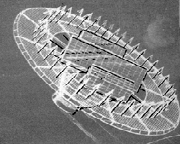|
Steering control is accomplished by applying different voltages to various
parts of the craft. The part with the high voltage gets more lift,
hence tilts up. The form of the Ionocraft doesn't matter. Any
shape will fly, but de Severs ky assumes that round models in the form
of a flying saucer will be the most easily maneuverable.
Commuter transport. With no size limit, you can pack trainloads
of people into this VTOL craft, relieve traffic congestion around urban
centers. The same type of craft used as long distance transport possibly
at supersonic speeds would not n eed big airports with long runways.
Grid is Hard to Hit.
Military reconnaissance and rescue. Without moving parts, the Ionocraft is less vulnerable to small arms fire than helicopters. The open grid makes a poor target. Most bullets would whiz right through it. Even if the grid is hit, the electric charge would be maintained despite damage to some portions. Unlike a copter with shattered blades, the Ionocraft would not crash. Weather observation. While satellites like Tiros look down on the atmosphere from outer space, Ionocraft could sail right into the weather making air layers, providing valuable supplemental information. Being steerable, Ionocraft would not drift with the wind like weather balloons, but could hold a position over crucial areas, making local forecasts more reliable. Skyborne antenna. Kept aloft indefinitely in a fixed position by a ground based energy supply, Ionocraft could also act as a defense radar. "It would be like raising the DEW line 60 miles up into the air," suggested de Severs ky, "adding 15 to 25 minutes warning time against missiles." |
||

| Page 1 | ||
| Page 4 | ||
| Page 2 | ||
| Page 5 | ||
| Page 3 | ||
| Page 6 | ||